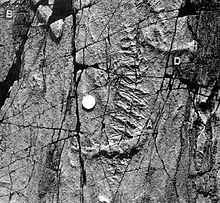Fractofusus misrai
| Fractofusus misrai | |
|---|---|
| Scientific classification | |
| Kingdom: | Animalia |
| Order: | Rangeomorpha |
| Genus: | Fractofusus |
| Species: | Fractofusus misrai Gehling et Narbonne, 2007 |
| Binomial name | |
| Fractofusus misrai | |
Fractofusus misrai is an Ediacaran fossil discovered in 1967 by S.B. Misra at Mistaken Point, Newfoundland and Labrador, Canada, which has since become the Mistaken Point Ecological Reserve.[1] It was named after Professor Misra in 2007.[2]
Discovery of vendian fossils in the Avalon Peninsula

In the summer of 1967, S.B. Misra an Indian graduate student (1966–69) at Newfoundland's Memorial University discovered a rich assemblage of imprints of soft bodied organisms on the surface of large rock slabs, while mapping the Conception Group of Avalon Peninsula of Newfoundland near Cape Race, at a place called Mistaken Point.
These unusual impressions of previously unknown soft-bodied sea animals on the surfaces of argillites (mudstone) included coelenterates and other metazoa of the Ediacarian period, 575 to 560 million years ago.[3] These fossils are records of the oldest known complex life forms that existed anywhere on Earth.[3] Misra was the first to prepare and present a systematic geological map of the region, to classify and describe the rock sequence of the area and to work out the depositional history of the rocks.
The description of the fossil assemblage together with their mode of occurrence, cause of sudden death, ecological conditions and chronological position form part of Misra's detailed thesis submitted for the degree of Master of Science. The discovery was reported in 1968 in Nature.[4] Misra described the Mistaken Point fauna in detail in 1969, in a paper published in the Bulletin of the Geological Society of America.[5]
He assorted the fossil assemblage into five groups, namely spindle-shaped, leaf-shaped, round lobate, dendrite like, and radiating. Each group was defined in terms of distribution and form, sub-categories and biological affinity.
The geological environment of the fossil-bearing rocks and the ecology of the animals that lived and died in the Conception Sea were described by Misra in two of his subsequent papers published in the Bulletin of the Geological Society of America in 1971[6] and in the Journal of the Geological Society of India in 1981.[7] Mistaken Point Ecological Reserve is a 5.7-km2 stretch of the coast that protects the fossils.[3]
See also
References
- ↑ BBC News (18 September 2007). "Rare honour for Indian geologist". BBC South Asia. Retrieved 10 July 2011.
- ↑ Gehling, James G (2007). "Spindle-shaped Ediacara fossils from the Mistaken Point assemblage, Avalon Zone, Newfoundland". Canadian Journal of Earth Sciences 44 (3): 367–387. doi:10.1139/e07-003.
- ↑ 3.0 3.1 3.2 Mistaken Point Ecological Reserve, Newfoundland and Labrador, Dept. of Environment and Conservation
- ↑ Anderson, M.M., and S.B. Misra. 1968. Fossils found in pre-Cambrian Conception Group of southeastern Newfoundland. Nature 220:680–681
- ↑ Misra, S.B. 1969. Late Precambrian(?) fossils from southeastern Newfoundland. Geological Society of America Bulletin 80:2133–2140
- ↑ Misra, S.B. 1971. Stratigraphy and depositional history of late Precambrian coelenterate-bearing rocks, southeastern Newfoundland. Geological Society of America Bulletin 82:979–988.
- ↑ Misra, S.B. 1981. Depositional Environment of the Late Precambrian Fossil-Bearing rocks of Southeastern Newfoundland, Canada. Journal of the Geological Society of India, Vol.22,No.8